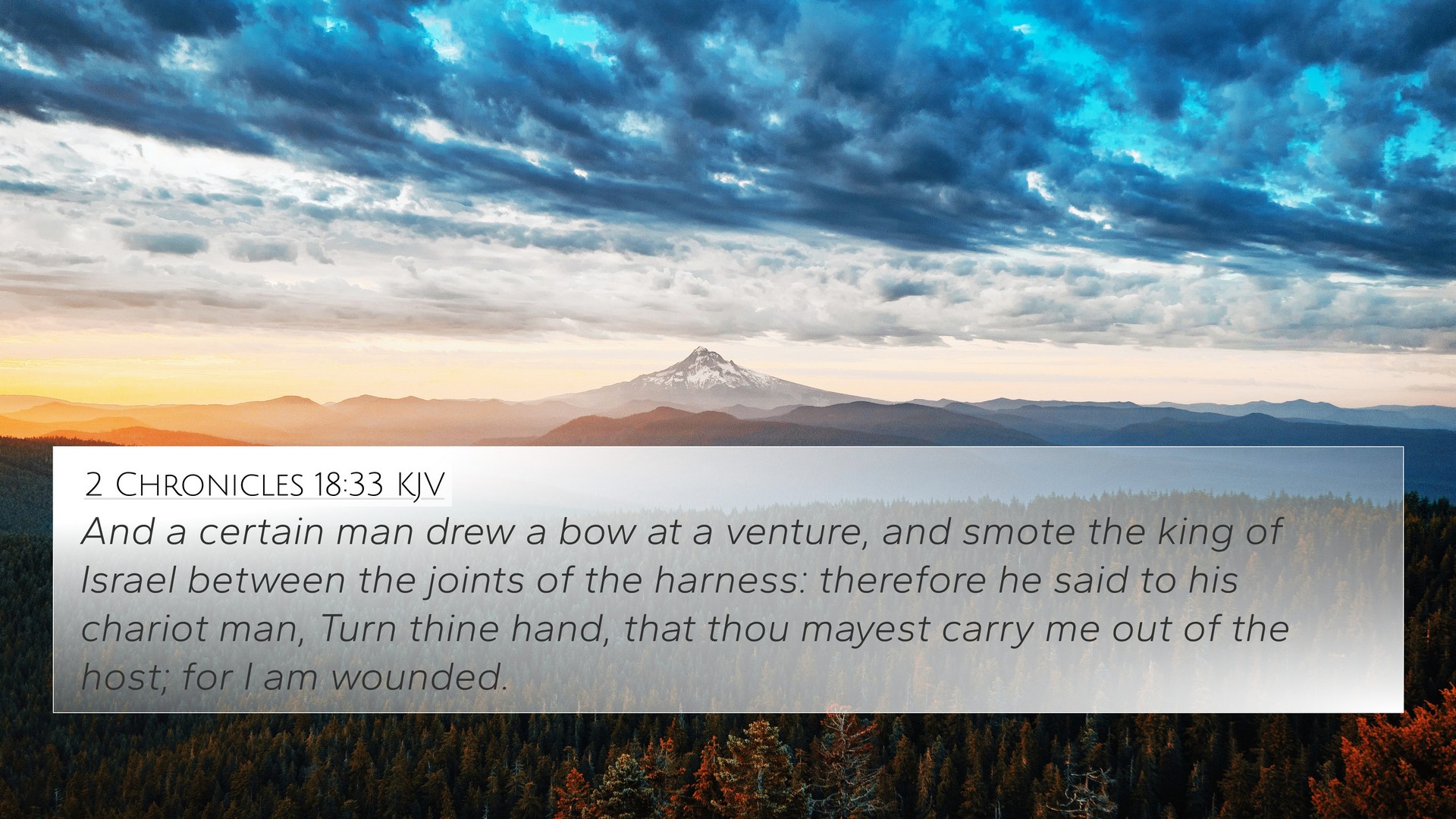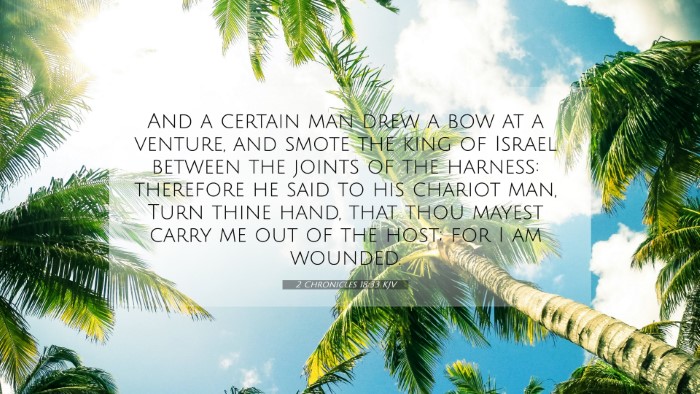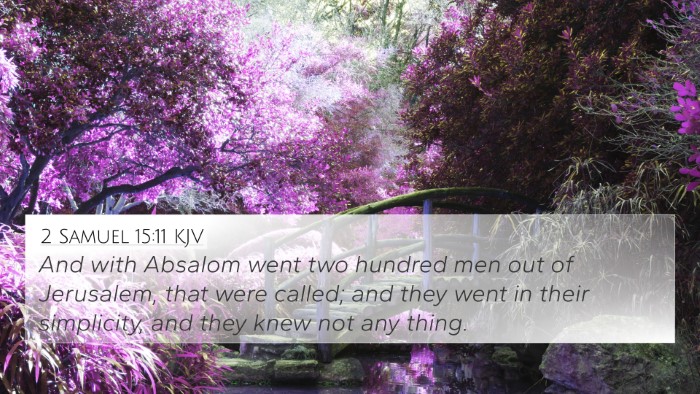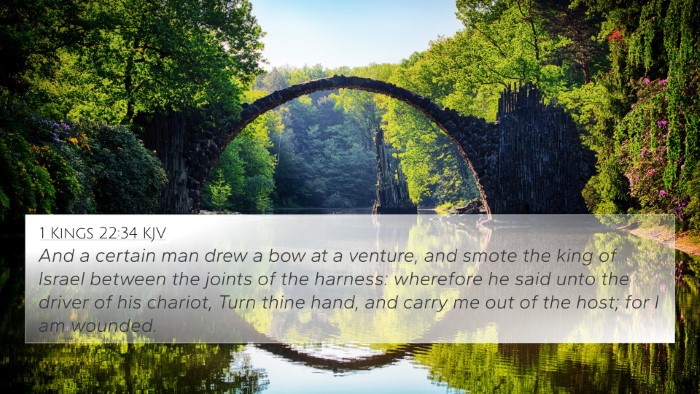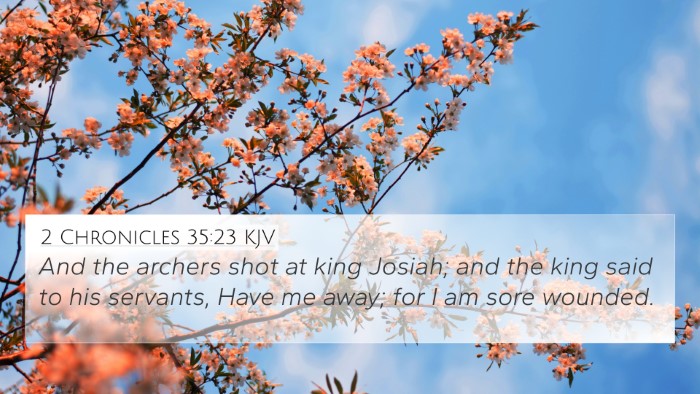Understanding 2 Chronicles 18:33
2 Chronicles 18:33 states, "And it came to pass, when the captains of the chariots saw Jehoshaphat, that they said, It is the king of Israel. Therefore they compassed about him to fight: but Jehoshaphat cried out, and the Lord helped him; and God moved them to depart from him." This verse provides a significant moment in the narrative of King Jehoshaphat during his alliance with King Ahab of Israel.
Commentary Insights
This verse demonstrates several crucial themes explored through public domain commentaries:
- Identity and Misidentification: Matthew Henry points out that Jehoshaphat's attire made him look like Ahab, leading to a grave misunderstanding by the captains of the chariots. This reflects upon how appearances can lead to perilous situations.
- Divine Intervention: Albert Barnes emphasizes the importance of Jehoshaphat's cry for help, illustrating the power of earnest prayer and reliance on God during times of danger.
- Divine Sovereignty: Adam Clarke notes that the 'Lord helped him' underlines God's providence and control over the events, even amidst human conflict and confusion.
- The Role of Fear: Commentaries often highlight Jehoshaphat’s fear as a natural human emotion, showing that even the most faithful can experience moments of doubt and distress.
- Consequences of Alliances: The verse is also a cautionary tale about the effects of forming alliances with the wicked, as it was Ahab’s earlier actions that brought Jehoshaphat into this risky affair.
Cross-References and Thematic Connections
This verse interconnects with several other biblical texts that reinforce its themes and enhance understanding:
- 1 Kings 22:31-32: A parallel account of the battle at Ramoth-Gilead where Ahab's actions lead to disastrous outcomes.
- Psalm 34:17: "The righteous cry, and the Lord hears, and delivers them out of all their troubles." This highlights God’s readiness to respond in times of distress.
- 2 Chronicles 20:9: Jehoshaphat later speaks of reliance on God during crisis, reinforcing the importance of faith.
- Jeremiah 15:21: God’s promise to protect those who call upon Him in times of trouble parallels Jehoshaphat's experience.
- Matthew 14:30-31: Peter’s cry to Jesus during the storm and Jesus’ immediate rescue serve as a New Testament reflection of divine assistance in crises.
- Hebrews 13:6: "I will not fear what man shall do unto me" resonates with Jehoshaphat's reliance on God's deliverance instead of being overwhelmed by his human adversaries.
- Isaiah 41:10: A declaration of God’s presence and assistance can be related to the help Jehoshaphat received.
Lessons and Applications
The passage of 2 Chronicles 18:33 provides profound lessons for believers:
- Dependence on God: In distress, like Jehoshaphat, believers are encouraged to cry out to God and trust in His intervention.
- Understanding Spiritual Warfare: The conflict here reflects a larger battle between good and evil, where understanding our identity in Christ is critically important.
- Awareness of Associations: The dangers stemming from alliances with those who may lead us astray highlight the necessity for discerning relationships.
Methods for Cross-Referencing in Scripture
For those eager to explore the connections between Bible verses, consider the following tools and methods:
- Bible Concordance: A tool that lists scripture verses in alphabetical order, allowing for easy location of passages related by keywords.
- Cross-Reference Bible Study: Engaging with multiple texts concurrently to draw thematic parallels enhances understanding of the Scriptures.
- Comprehensive Bible Cross-Reference Materials: Utilizing study Bibles or reference books that provide insights on related verses can deepen Bible study.
- Bible Chain References: Following a chain of related verses leads to a rich understanding of a theme through various scriptural perspectives.
- Community Dialogue: Discussing verses in Bible study groups encourages sharing insights and understanding diverse interpretations.
Conclusion
2 Chronicles 18:33 serves not only as a historical account of King Jehoshaphat's peril but also as a source of encouragement for believers facing their own battles. By studying this verse in conjunction with related scriptures, one can develop a deeper faith and trust in God’s protective power.
